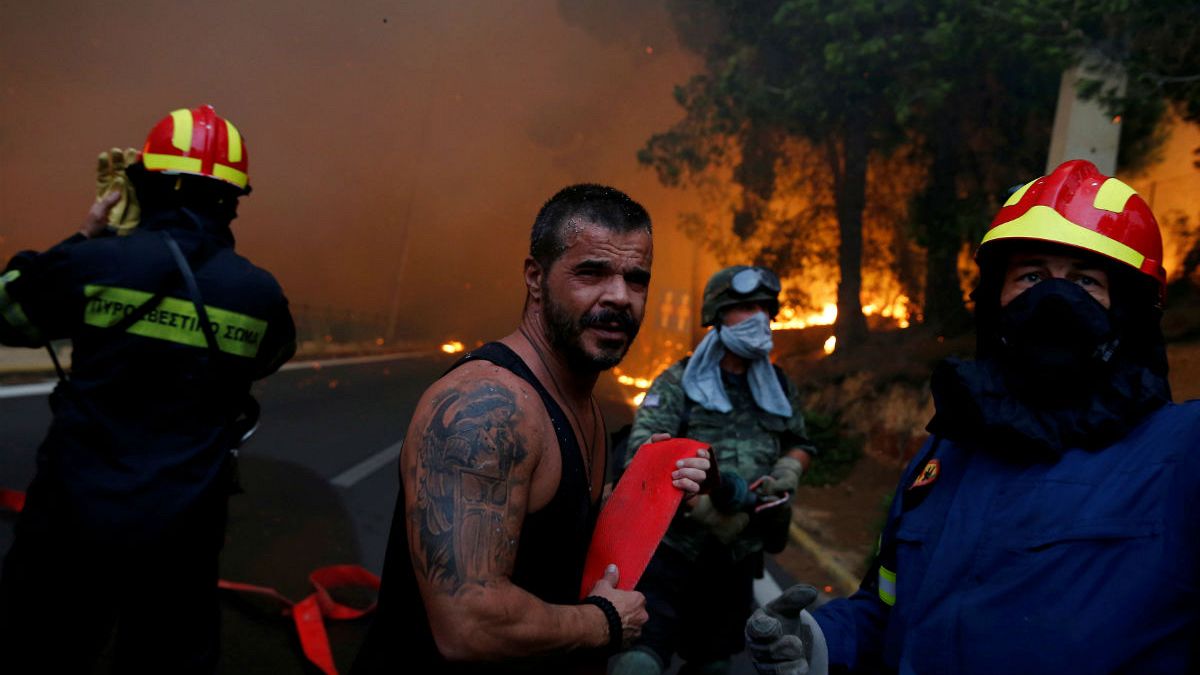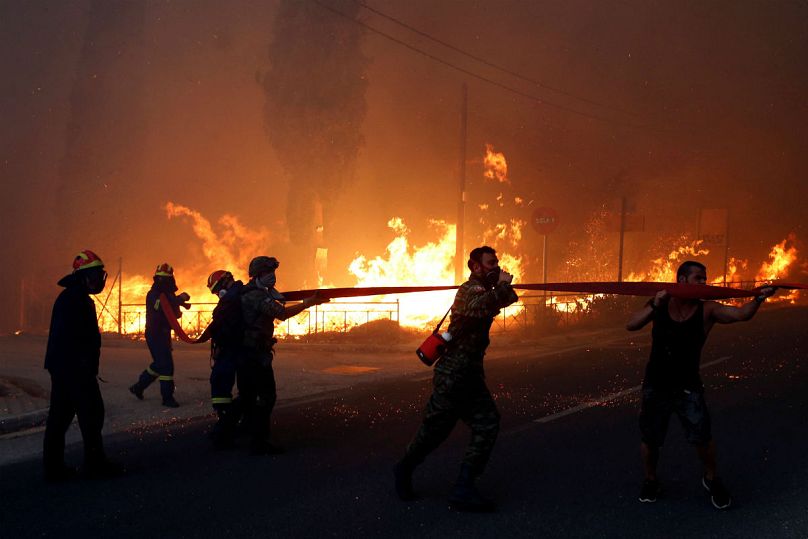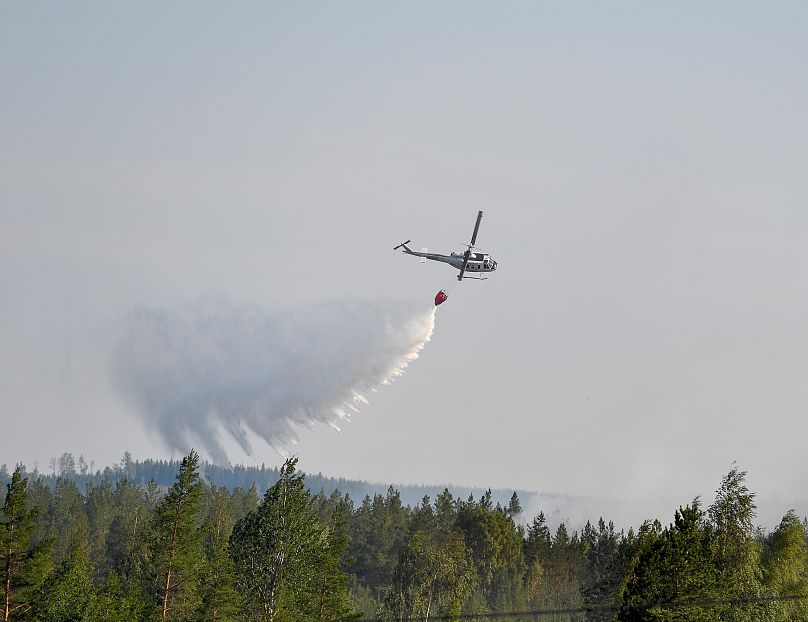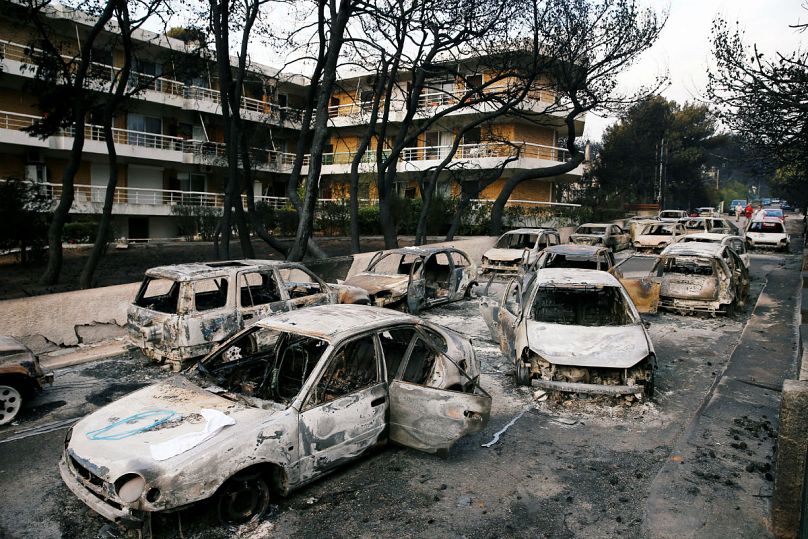You might think lots of water is the best way of putting out a wildfire. And you wouldn't be wrong. But there is a lot more to think about than that.
This is one of the most striking images from Greece’s deadly wildfires on Monday: a local helping out firefighters and the military to beat back the flames.
On one level it speaks about the desperation of the situation and how it threw together people to tackle a common goal.
But it also begs a question: how do the professionals go about tackling a wildfire? We spoke to experts from the European Forest Institute (EFI) to find out.
They do their homework
Wildfires — unlike structural blazes — are generally moving so it is important to do research and anticipate what they are likely to do next.
That is why more investment is going into knowledge as climate change throws up new challenges for fire crews, according to Marc Castellnou, a strategic fire analyst with the regional fire service in Catalonia.
“It helps us understand what a fire can and wants to do and where to put resources to really make a difference,” he told Euronews. “Instead of in the old days, when we just chased the flames.”
They monitor three key factors
Experts consider dozens of factors when they are doing their homework into what a fire might do in the coming hours.
But wind, whether the fire is on a slope and which direction it’s facing are the most important considerations, says Alexander Held, a senior expert at EFI.
Fires want to burn uphill, he added, so the steeper the slope the faster the fire will burn, he explained.
The direction of the blaze is also important: south-facing land is likely to be warmer and drier and therefore likelier to fuel the fire's flames.
They don’t go for the biggest flames
“You always tackle a wildfire from behind,” said Held. “You should not follow your instinct and go where the biggest flames are at the front. The engine of every wildfire is sitting at the back and you first want to switch off the engine.”
They try to stop the fire from spreading
When beginning, the back crews try and start from a point that provides a natural barrier to the blaze spreading.
These 'anchor points' can be roads, rivers or golf courses, for example.
Channels are then dug along the flanks of the blaze that remove vegetation so there is no fuel for the fire to spread outwards.
Vegetation is also removed from a fire’s path by burning it and these tactics together are known as dry firefighting.
“If you have water then this is the best measure to put the fire out,” said Held. “But in 80% of wildfires, you never have enough water."
“You’re not close to a hydrant or a river and the fire is moving, so there’s only so much you can pump in."
“We want to bring water in and we do everything to do it but to really put the fire out you have to understand dry firefighting.”
They realise the importance of ground crews
Some of the most impressive images from any wildfire clean-up operation are the planes swooping to drop water on the flames.
But experts say this is only a part of the operation.
“Even if you do put the fire out with water planes and water helicopters you need people to do the mop-up around the perimeter,” said Held
“If not you will never kill all the small smouldering fires. You can only cool it down and take away the flames for a bit."
“So in an ideal world, every drop by a water bomber would be followed on the ground by a hand crew.”
The recent moorland fires near Manchester, England, reignited because this ‘mopping-up’ wasn’t done properly, added Held.
They try and get organised
Major wildfire operations are turning to the Incident Command System (ICS), a standardised way of commanding, controlling and coordinating emergency response.
“In a big fire situation you have different agencies working together: the army, the air force, the police, the fire service, the forestry service,” said Held.
“If they are all trained in ICS it’s brilliant because you can drop into a position — in operations planning or logistics — and you agree to the same objectives and you speak the same language and terminology."
“We have this exchange at the moment, Germans going to Sweden. If they all work under ICS it’s very easy because everybody knows how the system works and when you bring in new resources you can slot them in a very efficient way.”
They have to accept sometimes there is nothing they can do
Castellnou said sometimes fires are just too intense to intervene and they have to wait and attack the flames during “windows of opportunity”.
This is where research has told crews when conditions are most favourable to contain the blaze.
“This means we have to identify places where the fire will be in a weak position,” said Castellnou.
“Instead of trying to put the flames out at any price, in front of the intense fires, we have to look for our opportunity.”
“If you have the right ingredients and weather: so a lot of dry fuel, difficult terrain, hot weather and wind are in alignment, there is not much you can do,” said Held.
“Situations like in Greece you can have another plane and ten more water bombers but it won’t make a difference.”





